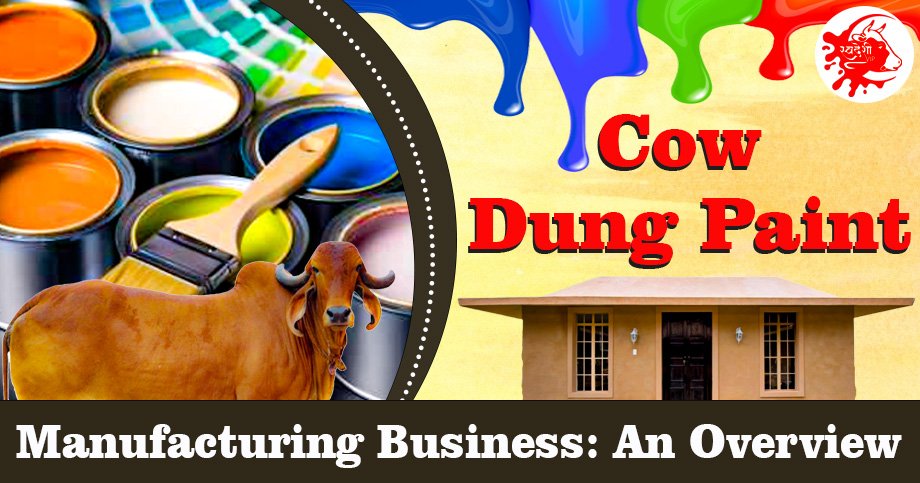
The religious value of cow dung in our nation makes the cow dung paint manufacturing business a good option. As we all comprehend, India is a religious country in which animals and birds, as well as numerous gods and goddesses, are worshipped. In this case, the cow is in the lead. In India, the cow has been elevated to the position of mother. The cow is a family heirloom. Cow’s milk and cow dung are important not only from a cultural standpoint but also from a scientific standpoint.
Cow’s milk is extremely beneficial to one’s health. But some people used to avoid animal husbandry because of the issue of cow dung. In the meantime, a few other people used it and absolutely adored milk cows and ended up leaving cows that did not give milk to roam around the streets. However, the popularity of cow dung has grown to the point where people are raising cows solely for the purpose of producing cow dung.
Cow dung is used to encase and wash the ground and walls due to its antibacterial properties. However, today we will tell you about a product produced from cow dung that is both natural and profitable. The said product is an organic cow dung paint produced from cow dung that has been seeing a wide range of business potential.
The Khadi and Village Industries Commission have made the decision to construct 500 units of natural Vedic paint. Such units are projected to directly employ approximately 6000 individuals in villages while also increasing the earnings of farmers and livestock rearers.
The whole initiative not only promises to create jobs but will also assist in strengthening the central government’s Atmanirbhar Bharat[1] Scheme. The said step is also taken with the aim of doubling farmer earnings in mind. The Khadi and Village Industries Commission (KVIC) is investigating a stable alternative source of income for cattle farmers using the new technology of “Khadi Prakritik” paint made from cow dung.
Cow dung paint is a creative, eco-friendly, and cost-effective item influenced by the ancient practice of coating the floors and ceilings of houses with cow dung. Besides scientific studies having to treat cow dung, this ancient tradition is modified into Emulsion Paint. The Khadi Commission created this creative paint with the intention of increasing farmers’ earnings, attempting to create sustainable livelihoods through transition and providing the highest paint to the public at large at an affordable price.
Cow dung Paint, or Khadi Prakritik Paint, varies from other paints on the market and provides some benefits (Cow Dung Paint vs. Other paint). Here’s a side-by-side comparison between these two paints.
Antibacterial: It has antibacterial effects because of the natural paint’s antibacterial properties. However, other paints in the business are not of this level of Quality.
Antifungal: Organic paint can prevent fungus, whereas other paints could be susceptible to fungus.
Environmental Support: Cow dung is the primary component of organic paint; it is environmentally friendly. Other paints contain the hazardous chemical.
Heat Insulation: Natural paint has a much higher heat resistance than other paints.
Odourless: Cow dung paint has no unpleasant smell of any kind. Another, on the other hand, has a foul smell.
Toxic-free: Cow dung paint contains no toxic ingredients. Other paints, on the other hand, contain hazardous toxic chemicals such as Xylene, Ethyl Acetate, Glycol, and Methylene Chloride.
Release from Heavy Metal: Cow dung paint contains no heavy elements. In other paints, heavy elements are used.
Here are some of the following raw materials used in making Cow Dung Paint:
You will also want a few machines to create this paint; here are some of the following list of machines which you need to make the paint:

The following describes the method used to produce this cow dung paint-
Plastic emulsion paint is also another form of paint. Linseed oil is mixed in with all of these ingredients. The solution is then diluted with a whitener. When we combine this with distemper paint, we get plastic emulsion paint. It has a huge amount of sparkle.
The following is additional information on the chemical elements that must be mixed in 1 kg of distemper and 1 litre of plastic emulsion pain:
400 gm of Precipitated Calcium Carbonate (CaCo3), 100 gm of Titanium Dioxide (TiO2), 100 ml of binder, 50 gm of Hydroxyethyl Cellulose (HEC), and 20 gm of Sodium Benzoate are required to make 1 kg of distemper paint.
Likewise, 400 gm of Precipitated Calcium Carbonate (CaCo3), 150 gm of Titanium Dioxide (TiO2), 150 ml of binder, 50 gm of Hydroxyethyl Cellulose (HEC), 20 gm of Sodium Benzoate, and 100 ml of Long DCO Oil (LDCO) are required to produce 1 litre of emulsion paint.
You will also receive a 35% tax incentive on the overall cost under the Prime Minister’s Employment Program of Ministry. You must register your business as an MSME in order to receive subsidies. MSME would then send all of your information to the bank after registration. Just after the receipt of the loan from the bank, the government subsidy amount is deposited in the bank within 3 to 4 days.
At SwadeshiVIP, we train individuals who like to gain more knowledge about cow dung painting. You can learn the whole process in 5 days.
Conclusion
We hope that from this blog, you’ve received insightful information regarding Cow dung paint. Cow dung paint is an eco-friendly paint which will make your home a happy and decent place to live. As we all know that the products from cows are really natural and organic by using Cow dung paint, you can change your lifestyle by using natural and organic products.
For information related to cow dung paint, connect with us at SwadeshiVIP; we provide you with the best assistance in the whole process!
Read Our Article: Cow Dung Brick Manufacturing Business
